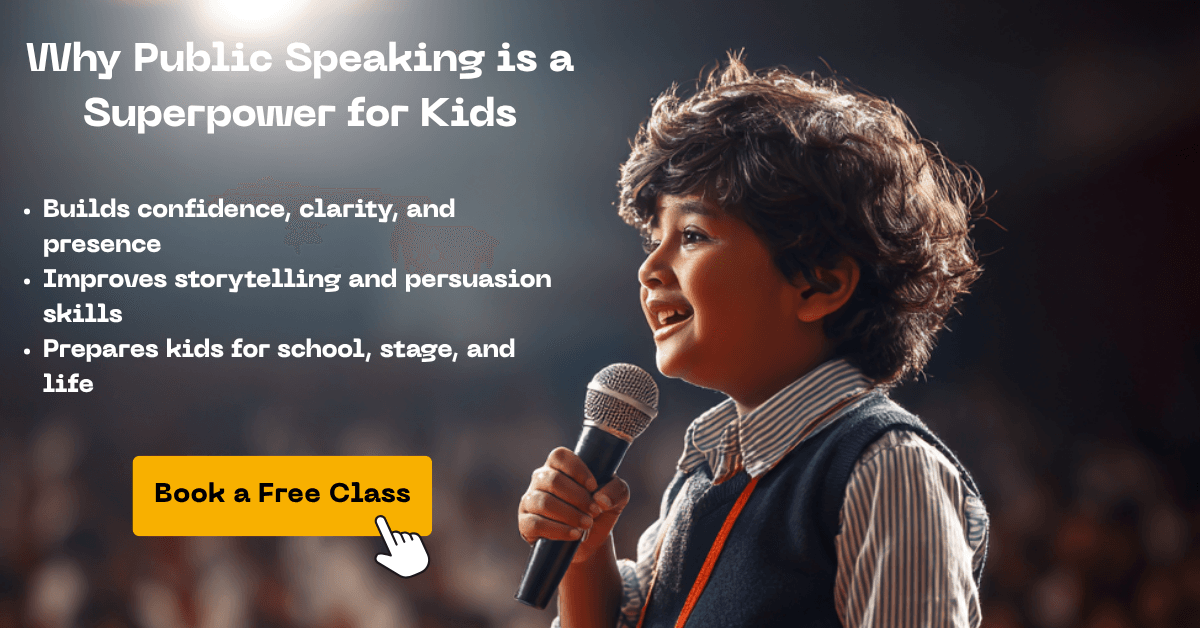Top Storybooks to Build Confidence and Expression in Kids

Table of Contents
- The Power of Storybooks in Building Confidence
- 1. The Gruffalo by Julia Donaldson: A Tale of Courage and Cl
- 2. The Paper Bag Princess by Robert Munsch: A Story of Empow
- 3. Where the Wild Things Are by Maurice Sendak: Imagining wi
- 4. Matilda by Roald Dahl Finding Strength in Words
- 5. The Day the Crayons Quit by Drew Daywalt: Finding Voice a
- 6. Charlie and the Chocolate Factory by Roald Dahl: Expressi
- 7. Oh, the Places You’ll Go! by Dr. Seuss: Building Optimism
- 8. The Rainbow Fish by Marcus Pfister: Confidence Through Ki
- 9. Wonder by R.J. Palacio: Finding Courage to Speak and Stan
- Why Choose PlanetSpark: Empowering Every Child to Speak with
- Turning Storybooks into Confidence Catalysts
In a world where confident communication is the key to success, developing stage presence and expressive ability from a young age can make a lasting difference. Storybooks are not just sources of entertainment; they are powerful learning tools that help children express themselves, articulate thoughts clearly, and speak confidently in front of others.
This blog explores the best story books to read that build stage confidence and expression in children, nurturing them into imaginative thinkers and confident speakers.
The Power of Storybooks in Building Confidence
Storybooks play a vital role in shaping a child’s imagination and voice. Reading stories aloud enhances vocabulary, pronunciation, and emotional expression, essential skills for stage performance and public speaking.
Through engaging tales, children learn how characters express emotions, persuade others, and tell stories that captivate audiences.
Here’s how reading story books helps:
Improves articulation and voice modulation naturally.
Encourages empathy and emotional connection through characters.
Builds confidence to speak in front of peers or audiences.
Enhances storytelling and expressive communication.
Makes learning English fun and interactive.
Storybooks make learning expressive communication a joyful, pressure-free experience, a foundation for confident speakers.

1. The Gruffalo by Julia Donaldson: A Tale of Courage and Clever Expression
One of the most loved story books to read for kids, The Gruffalo teaches courage and wit through rhyme and rhythm.
The little mouse’s bravery and quick thinking encourage children to use their imagination, voice tone, and facial expressions to narrate confidently.
Key Takeaways for Kids:
Boosts confidence through rhythmic storytelling.
Encourages expressive reading with voice modulation.
Teaches the power of clever communication under pressure.
Teachers and parents often use this book for dramatization activities that improve both stage confidence and verbal clarity.
2. The Paper Bag Princess by Robert Munsch: A Story of Empowerment
This story book inspires children to believe in themselves and speak up for what’s right. Princess Elizabeth’s boldness makes it a perfect read for enhancing assertiveness and expressive confidence.
How It Helps in Stage Expression:
Promotes self-assurance and individuality.
Inspires kids to use strong, positive language.
Encourages character roleplay, helping children emote and speak confidently.
The narrative’s humor and empowering message make it ideal for storytelling practice sessions or classroom performances.
3. Where the Wild Things Are by Maurice Sendak: Imagining with Expression
A timeless story book to read aloud, this classic encourages kids to embrace their imagination and express emotions freely.
As Max journeys into the world of the Wild Things, children relate to his emotions — excitement, anger, joy, which enhances emotional expression.
Why It Builds Confidence:
Inspires creativity and dramatic expression.
Helps children connect emotions to voice and gestures.
Builds stage presence through imaginative retelling.
When children perform scenes or retell Max’s story, they naturally learn how to use their voice, body language, and expressions effectively.
Give your child the gift of confidence through creative expression and storytelling.
Enroll with PlanetSpark’s Communication and Public Speaking Program
4. Matilda by Roald Dahl Finding Strength in Words
Matilda is one of those story books that nurture both imagination and empowerment. Through her intelligence and love for reading, Matilda teaches children that words have power, a core idea for developing strong communicators.
Learning Outcomes for Young Speakers:
Enhances vocabulary and sentence fluency.
Shows how reading builds self-confidence and courage.
Encourages expressive storytelling through humor and emotion.
Children love reenacting Matilda’s scenes, a fun way to practice speaking confidently and with conviction.
5. The Day the Crayons Quit by Drew Daywalt: Finding Voice and Emotion
This delightful stories book teaches children how every voice matters. Each crayon expresses its feelings uniquely, helping kids understand tone, perspective, and emotional expression, all essential for public speaking and creative writing.
Why It’s Perfect for Stage Confidence:
Encourages using voice tone to express emotion.
Builds empathy through understanding different perspectives.
Motivates kids to present their ideas confidently.
When children read or act out the crayons’ letters, they practice inflection, pacing, and expression, vital communication skills for any young performer.
6. Charlie and the Chocolate Factory by Roald Dahl: Expressive Storytelling at Its Best
This engaging story book to read is perfect for building imagination and stage confidence. The colorful characters and dialogues give children a chance to explore various emotions and tones.
Confidence Boosting Benefits:
Improves expressive reading through lively characters.
Enhances storytelling with humor and creative imagination.
Encourages participation in dramatic reading or skits.
The book’s vibrant language and visual storytelling make it a wonderful resource for reading aloud or performing short plays at school or home.

7. Oh, the Places You’ll Go! by Dr. Seuss: Building Optimism and Voice Confidence
One of the most inspiring story books to read for children, Oh, the Places You’ll Go! by Dr. Seuss, encourages optimism, perseverance, and belief in oneself.
The rhythmic verses and motivational tone make it ideal for children to practice expressive reading and confidence in speech delivery.
How It Builds Expression and Stage Presence:
Motivates children to read aloud with energy and rhythm.
Encourages positive self-talk, enhancing speaking confidence.
Helps kids use tone, pace, and emotion naturally while reading.
This story book is a favorite in speech competitions and classroom storytelling sessions, where kids learn to deliver messages with clarity, hope, and confidence.
8. The Rainbow Fish by Marcus Pfister: Confidence Through Kindness and Sharing
The Rainbow Fish is a timeless stories book that teaches empathy, generosity, and emotional connection traits that enhance expressive storytelling. When children connect emotionally with a story, they speak more naturally and confidently.
Why It’s a Must-Read:
Strengthens emotional intelligence and verbal empathy.
Encourages kids to speak with sincerity and authenticity.
Teaches meaningful communication beyond words.
When children retell the story or act out scenes, they practice combining gentle tone and expressive gestures, helping them become better communicators and listeners.
9. Wonder by R.J. Palacio: Finding Courage to Speak and Stand Tall
For slightly older kids, Wonder is one of the best story books to read that teaches self-expression, courage, and empathy.
The story of August Pullman, a boy with facial differences, encourages children to embrace individuality and express themselves with confidence.
Benefits for Developing Stage Confidence:
Inspires empathy-driven storytelling and awareness.
Builds courage to face audiences and express emotions freely.
Encourages perspective-taking and reflective communication.
Children who read Wonder often gain not just vocabulary, but the emotional depth that shapes confident, compassionate speakers.
Why Choose PlanetSpark: Empowering Every Child to Speak with Confidence
At PlanetSpark, we believe storytelling isn’t just about reading, it’s about expressing ideas with emotion, clarity, and confidence. Our programs are designed to transform shy readers into bold communicators through structured, fun-based learning.
Here’s why parents trust PlanetSpark:
- 1:1 Expert Coaching: Personalized feedback from certified communication and child psychology trainers.
- Step-by-Step Skill Building: Covers body language, voice modulation, storytelling, debating, and persuasive speech.
- TED-Style Training: Students learn the “Hook–Message–Story–CTA” framework like TEDx speakers.
- Global Practice Platforms: Live debates, discussions, and storytelling circles with peers from 13+ countries.
- Competitions & Leagues: Regular contests and a national-level Public Speaking League build real-world confidence.
- Video Feedback Loop: Students review recorded speeches with coaches for improvement.
Whether it’s reading aloud, performing, or presenting ideas, PlanetSpark’s unique storytelling-based approach empowers every child to communicate confidently in school and beyond.
Turning Storybooks into Confidence Catalysts
Storybooks are more than bedtime companions they are bridges to confidence, creativity, and self-expression.
Each story book to read shared above not only entertains but also nurtures vital communication and public speaking skills. When children learn to articulate emotions, perform stories, and share their thoughts confidently, they gain the lifelong skill of expression.
Reading, speaking, and storytelling together create a powerful trio for confidence-building. As parents and educators, providing children with these books and opportunities to express themselves can transform their communication journey.
Encourage your child to read, speak, and express and watch how stories turn into confidence on stage and in life.
Transform your child into a confident speaker with PlanetSpark’s storytelling-led learning.
Frequently Asked Questions
Storybooks expose children to expressive language, emotions, and dialogues that they can mimic and perform. When kids read aloud or act out stories, they practice using their voice, gestures, and facial expressions. This builds their ability to speak clearly, handle audiences confidently, and overcome stage fright in a fun, low-pressure way.
Books like The Gruffalo, Where the Wild Things Are, and The Day the Crayons Quit are excellent for expressive reading. Their rhythmic patterns, emotional dialogues, and relatable characters encourage children to play with tone, pitch, and energy while reading, essential for developing expressive communication.
Children can start reading storybooks as early as 3–4 years old. At this age, picture books and simple stories help them understand emotions, words, and rhythm. As they grow, moving on to story books with deeper themes like Matilda or Wonder enhances both self-expression and verbal confidence.
Reading storybooks regularly introduces children to new vocabulary, sentence structures, and natural language flow. This enhances their spoken English fluency and articulation. Over time, they start speaking more confidently, using expressive tone and accurate pronunciation, which improves their overall communication ability.
Parents can encourage children to retell stories in their own words, perform short character roles, or narrate favorite scenes. Recording these performances or organizing mini “story sessions” at home boosts confidence and stage presence. It helps children express thoughts clearly while having fun with storytelling.
Personalized Communication Report
Record a video to get a AI generated personalized communication report for your child

Hi There, want to try these
tips for your child with
LIVE with our expert coach?
Let's check your child's
English fluency
